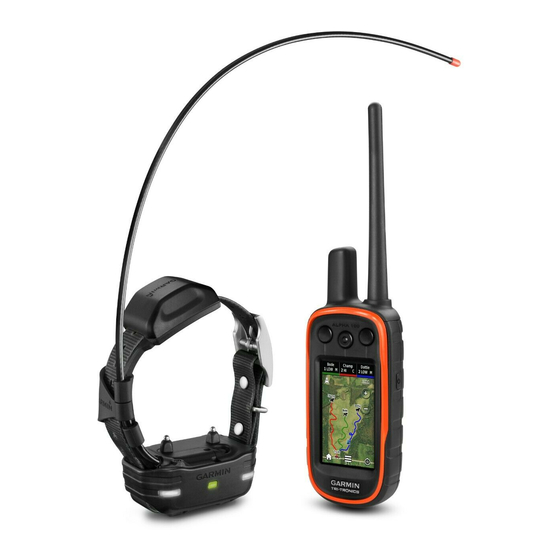Garmin Alpha 100 with TT 15 mini Посібник користувача - Сторінка 13
Переглянути онлайн або завантажити pdf Посібник користувача для Засіб для догляду за домашніми тваринами Garmin Alpha 100 with TT 15 mini. Garmin Alpha 100 with TT 15 mini 26 сторінок.

Repositioning a Waypoint to Your Current Location
You can change the position of a waypoint. For example, if you
move your vehicle, you can change the location to your current
position.
1
Select
> Waypoint Manager.
2
Select a waypoint.
3
Select
> Reposition Here.
The waypoint location changes to your current location.
Moving a Waypoint on the Map
1
Select
> Waypoint Manager.
2
Select a waypoint.
3
Select
> Move Waypoint.
4
Select the new location on the map.
5
Select Move.
Increasing the Accuracy of a Waypoint Location
You can refine a waypoint location for more accuracy. When
averaging, the device takes several readings at the same
location and uses the average value to provide more accuracy.
1
Select
> Waypoint Manager.
2
Select a waypoint.
3
Select
> Average Location.
4
Move to the waypoint location.
5
Select Start.
6
Follow the on-screen instructions.
7
When the confidence status bar reaches 100%, select Save.
For best results, collect 4 to 8 samples for the waypoint, waiting
at least 90 minutes between samples.
Projecting a Waypoint
You can create a new location by projecting the distance and
bearing from a marked location to a new location.
1
Select
> Waypoint Manager.
2
Select a waypoint.
3
Select
> Project Waypoint.
4
Enter the bearing, and select
5
Select a unit of measure.
6
Enter the distance, and select
7
Select Save.
Deleting a Waypoint
1
Select
> Waypoint Manager.
2
Select a waypoint.
3
Select
> Delete > Yes.
Routes
A route is a sequence of waypoints or locations that leads you to
your final destination.
Creating a Route
1
Select
> Route Planner > Create Route > Select First
Point.
2
Select a category.
3
Select the first point on the route.
4
Select Use > Select Next Point.
5
Select a point.
6
Repeat steps 3 through 6 to add all the points in the route.
Editing the Name of a Route
1
Select
> Route Planner.
2
Select a route.
Waypoints, Routes, and Tracks
.
.
3
Select Change Name.
4
Enter the new name, and select
Navigating a Saved Route
1
Select
> Route Planner.
2
Select a route.
3
Select View Map > Go.
4
Navigate using the compass
Pointer, page
10) or map
Editing a Route
1
Select
> Route Planner.
2
Select a route.
3
Select Edit Route.
4
Select a point.
5
Select an option:
• To view the point on the map, select Review.
• To change the order of the points on the route, select
Move Up or Move Down.
• To insert an additional point on the route, select Insert.
The additional point is inserted before the point you are
editing.
• To remove the point from the route, select Remove.
Reversing a Route
1
Select
> Route Planner.
2
Select a route.
3
Select Reverse Route.
Viewing a Route on the Map
1
Select
> Route Planner.
2
Select a route.
3
Select View Map.
Viewing the Active Route
1
Select
> Active Route.
2
Select a point in the route to view additional details.
Deleting a Route
1
Select
> Route Planner.
2
Select a route.
3
Select Delete Route > Yes.
Tracks
A track is a recording of your path. The track log contains
information about points along the recorded path, including time,
location, and elevation for each point.
Recording Track Logs
1
Select
> Setup > Tracks > Track Log.
2
Select Record, Do Not Show or Record, Show On Map.
If you select Record, Show On Map, a line on the map
indicates your track.
3
Select Record Method.
4
Select an option:
• To record tracks at a variable rate that create an optimum
representation of your tracks, select Auto.
• To record tracks at a specified distance, select Distance.
• To record tracks at a specified time, select Time.
5
Select Interval.
6
Complete an action:
• If you selected Auto for the Record Method, select an
option to record tracks more or less often.
.
(Navigating with the Bearing
(Map, page
10).
9
